
Don’t Forget Me is Maggie’s third proper album (she has had several EPs and demo compilations). Each album is a step forward, and this is her best. Her debut, 2019’s Heard It in a Past Life, had great singles but was not a cohesive album. It fused a folkie singer-songwriter groove with EDM in a natural way. Her second, Surrender (2022), felt like an album; it was a cohesive whole album. Surrender sounded more mature and self-assured, it had an 80s New Wave rock vibe. On Don’t Forget Me, Rogers has found the Maggie Rogers sound: a soft rock guitar-forward production and an updated version of a 70s singer-songwriter vibe. There is a quiet confidence in Rogers; she sounds comfortable as a pop star – or, as she says in a recent profile in Vogue regarding Don’t Forget Me:
“This is what I sound like when I’m just breathing.”
“There are so many different memories woven into the tapestry of this record, from across the span of my 20s. I’m turning 30 at the end of April. This record does feel in many ways like this really woven memory blanket of this long span of my life.”
Vogue 4/12/24
Per the pre-release hype, the songs poured out of her, with the help of co-writer Ian Fitchuk in a week. This kind of explosion of creativity was new to Rogers, as was the collaboration with Fitchuk.
“Rogers wrote most of the record with the producer Ian Fitchuk. They met in Los Angeles in 2019, when Fitchuk was there for the Grammy Awards. (He was a co-writer and co-producer on Kacey Musgraves’s “Golden Hour,” which won both Album of the Year and Best Country Album.)”
From The New Yorker published in the print edition of the April 15, 2024, issue, with the headline “The Modern Pulpit.”
The music on the album is generally upbeat, which is an intriguing contradiction to the mostly pensive lyrics. The lyrics of the bouncy opening track, “It Was Coming All Along,” are melancholy: Mom is getting ready to sell the family home, the narrator is approaching thirty, and feeling the weight of adulthood when the heady days of her early twenties don’t seem that far away. But it is not chronic: “…a honey shade of blue…But I know it won’t last for long.”
The confidence I hear in the album is highlighted in “Drunk,” where the narrator says:
“I’m drunk, not drinkin’
Lost in wishful thinkin’
‘Round and ’round and ’round and ’round and ’round it goes
I can hear them whisperin’
Call, but I’m not listenin'”
On her last tour, Rogers would introduce “So Sick of Dreaming” as “a story that my friend told me about someone being sorta shitty.” The narrator tells the story of a loser boyfriend and how the narrator is tired of dealing with this situation and dreaming they will somehow get better. She is ready to move on.
In the context of a rock song, “The Kill” tells the story of lovers who are not on the same page. Ultimately, the couple “were just wasting time.”
“If Now Was Then” is a beautiful song about regret and “what if?” The conclusion is that no matter what, you can’t fix the past.
“But if now was then, I would get out of my head
I would touch your chest, I would break the bed
I would say the things that I never said
Oh, the things I’d do, oh, if now was then
But you can’t take it back
But you can’t take it back“
“I Still Do” is a piano ballad in Carole King’s style. Rogers even has some King vocal mannerisms. Despite losing a failed relationship, it was worth it – no regrets.
“‘Cause love is not a debt you pay
It’s not something you can give away
Love is not the final straw
But it’s always a reason to risk it all”
“On & On & On” is the most impressive vocal performance on the album. Lyrically, the narrator warns their ex-lover to move on: “Yeah, you better run.”
The narrator of “Never Going Home” is conflicted; they have fond memories of early in the relationship, but know the spark can’t be reignited: “…you kept me waiting…now I’m never, ever going home.”
“All the Same” is a piano and acoustic guitar ballad with a heartbreaking sound and lyrics to match:
“And still you wish for one more kiss
A moment’s bliss from a lover you’ve always known
Ooh, so it goes”
Maggie sticks the landing with the final and titular track, “Don’t Forget Me.” When this teaser single came out in early February, I was stoked that Don’t Forget Me would be a good album, and now, hearing it, Maggie has delivered. The song has a great musical hook and is the best song on the album. Like many of the songs on the album, it has a lot of conflicted emotions: disappointment she has not found “the one” offset by an admission that she is not ready to settle down anyway. She accepts that the next lover likely won’t be the one and is ok with that.
“So close the door and change the channel
Give me something I can handle
A good lover or someone who’s nice to me
Take my money, wreck my Sundays
Love me ’til your next somebody
Oh, and promise me that when it’s time to leave
Don’t forget me
Don’t forget me”
With Don’t Forget Me (the album), Rogers states that she is a pop star who will be around for a while and can be considered with the great 70s singer-songwriter who paved the way for her. This is an excellent roll-your-car-windows-down and sing-along summer album.
Vinyl Note: After several days of streaming Don’t Forget Me on Tidal (24-bit/96 kHz), I picked up the vinyl LP. The high-resolution stream sounded great, but the vinyl (Dogwood Green Edition) enhances the album’s organic sonics. It’s an excellent, clean pressing.


The Tortured Poets Department: The Anthology
(2024)
Like all things Taylor Swift, this new album has gotten a lot of press. Typically, the critical consensus is positive for a new Taylor Swift album. The reviews for The Tortured Poets Department: The Anthology (TTPD for short) are not overly negative but are not the usual fawning praise. So, for Taylor, this is a flop. The biggest complaints are the length of TTPD (31 songs and a little over 2 hours), the firehose of recordings that have been released over the last few years (new albums, re-recordings, bonus material, etc.), and overexposure (The Eras Tour, Travis, etc.). Some people are suffering from Taylor fatigue, but I am not. I was looking forward to this new album, following all things Taylor on social media, and was stoked when TTPD turned out to be double the length of what was initially marketed.
There is a difference between a Swifty and a Taylor Swift fan. A Swifty knows every word to her every song and is a collector of every nuance of her life (boyfriends, exes, slights, etc.); that is, they are obsessed with Taylor Swift. A fan likes her music and performances but falls short of obsession. Although I consider myself a musichead, there are no artists I am obsessed with in the same way as a typical Swifty. Bob Dylan comes the closest for me, but I have learned over the years that I am a mere piker compared to how obsessed one can become with Dylan (he has Swifty-like obsessives). I don’t look down on Swifties; I am jealous of that level of enthusiasm for an artist or band. I am merely a Taylor Swift fan.
As a mere fan, I am not in a position to fully excavate this album. I cannot speculate which songs are about Joe, Matty, or Travis, and I don’t care. My approach to a musician who writes in an autobiographical (autofiction) style like Taylor is to assume the narrator of the songs is a character and not concern myself whether the narrator is the artist or the subject of the song is a famous person. I am minimally interested in the gossip of decoding fact from fiction in a song. I am here to enjoy the story, the sonics, and the performance.
My first reaction to TTPD was that there is a sonic sameness that would get tedious over 31 songs and two hours. In addition, it was a sonic rehashing of the folklore, evermore, and Midnight’s eras: Antonoff’s atmospheric synth noodling and Aaron Dressner’s pop-folk and piano ballads. None of the songs stuck out as bangers. Lyrically, it is a breakup album. I don’t have an issue with the breakup songs/albums as the breakup trope is often effective (as in the best of an artist’s catalog – see Dylan’s Blood On The Tracks), and Swift is the master of the breakup trope. My first reaction was: “Don’t hate it; it is just meh.” Taylor Swift has enough goodwill with me that I felt obligated to give it more time to breathe.
I have had more time with the album, which is a grower (an album that gets better with each listen). The sameness of the sonics has faded, and I hear the uniqueness of each track. Granted, there are no new sounds here, but I have yet to tire of Jack Antsnoff and Aaron Dessner’s sonics. I find their collaboration with Swift to be the perfect cocktail. I now hear bangers. The main album (tracks 1 – 16 released first and are on the physical editions) sounds like finished tracks, whereas some of the second album (tracks 17-31) have a demo feel.
The songs have clever lyrics and exciting stories. Swift shares various moods and attitudes: resignation, sadness, anger, vengeance, wistfulness, etc. There are several targets: exes, fans, a new boyfriend, skeptics, and critics – most intriguingly, the artist herself. Unlike the third-person narratives of folklore and evermore, TTPS is first-person autofiction. I know enough Taylor gossip to guess which songs are about Joe vs. Matty, but I am trying to avoid the gossip and take the narratives at face value. I find the storytelling engaging.
I don’t have a problem with the length. It is a bit of a brain dump, and I am sure that if Taylor had constrained herself to ten songs and had more crisp editing within songs, this would be considered a more substantial album in the Taylor canon. I prefer to hear TTPD as a raw and meandering album. I would rather hear the “bonus material” now, in real-time, vs. how most artists do it via an anniversary edition a decade or two into the future.
I am enjoying TTPS even though I don’t find it a masterpiece. It’s an exciting and entertaining work by Swift, one of my lifetime’s most successful pop musicians. Like all greats, like my beloved Bob Dylan, even the flops are intriguing. TTPS is, at the very least, fascinating.
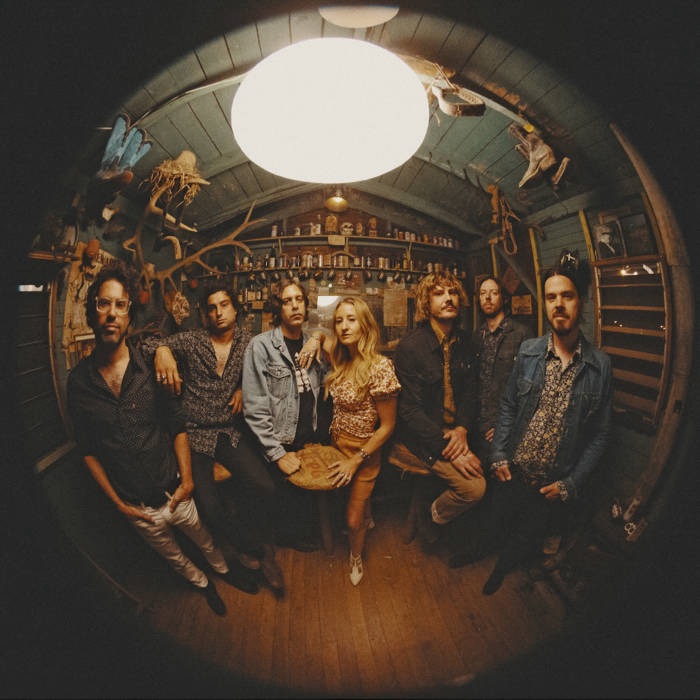
One of my favorite albums of 2023 was Margo Price’s Strays (released in January). I was delighted in October of 2023 when she released a sequel, Strays II. The sequel has the same vibe as Strays and comes from the same Jonathan Wilson-produced sessions. I am a huge fan of Wilson (both as a performer and as a producer). Most songs from both albums were written by Margo and her husband, Jeremy Ivy. Strays II has the same psychedelic late 70s classic rock feel as its predecessor. Although it is retro, it sounds fresh.
Strays II was marketed as an expanded re-release of Strays. It was promoted with three “acts” of songs. “Act I: Topanga Canyon” was released on August 22, 2023. “Act II: Mind Travel” was released on September 14, 2023. The complete Strays II and “Act III: Burn Whatever’s’ Left” was released on October 13, 2023. The vinyl edition of Strays II was released in January of 2024. Despite how it was marketed and promoted, Strays II is not bonus material or leftovers. Everything on II is as good as I – I slightly prefer II.

My elevator pitch for Margo Price is that she is a female Tom Petty, and both Stays albums have Mike Campbell as a guest musician to legitimize the Petty comparison. Campbell was Tom Petty’s guitarist and co-writer. He was part of Mudcrutch (a Petty side project), the most recent touring version of Fleetwood Mac, his current band, The Dirty Knobs, and he is a session ace extraordinaire.
The album opens with the titular song, per Price:
The title track is the story of how my husband, Jeremy [Ivey], and I met and fell in love in Nashville two decades ago. I wrote most of the words and Jeremy wrote the chords and melody. It also reflects how we have always tried to stay true to who we are as people: “Love and pain it comes in waves but it was quite enough in those early days, we were wild as wolves my darlin’, we were strays.”
Pitchfork
“Closer I Get” feature Ny Oh. Ny is a New Zealand folk singer, songwriter, and multi-instrumentalist. She is the lead singer of the band Neon Gru and has toured with Harry Styles as a multi-instrumentalist. She is the perfect backup vocalist for Margo. Per Margo, the song was:
…originally meant to open this double album with the line, “Being alive costs a lot of money but so does dying.” I’ve always thought it was unfair that the moment we are born, we immediately start racking up debt just for existing. This song was conjured from the ashes of our initial psychedelic trip—sometimes your perception and depth of field changes depending on where you’re at in life.
Pitchfork
“Malibu” is my favorite song from the whole project. This song has a solid Petty vibe. In addition to Campbell, the song also features Jonathan Wilson and Buck Meek (Big Thief). Per Margo:
“Malibu” was written with Mike Campbell in his Malibu home after Jeremy and I had driven through the canyon fleeing a forest fire to get my guitar from our Airbnb. I had the start of the song and brought it to him looking to finish it out. I wanted to write something with a country funk/Bobbie Gentry feel, a good long rambling story about the minutiae of the day, like “Ode to Billie Joe.” Mike added the long “California” yodel and the bridge and was exactly what the song needed. My favorite line is, “Love and grief are a package deal, the more you have, the more you feel.
Pitchfork
“Black Wolf Blues” – per Margo (from Holler)
“I love how these songs came together. ‘Black Wolf Blues’ in particular, Jeremy started writing the words from my exact point of view – he found myself reflecting on my ancestors, my grandparents (Paul & Mary Price) and their love and how it grew despite the drought and the loss of their farm. I wrote the chords and the melody and helped finish the verses and chorus. Even though it has a sweetness and a nostalgic way about it, there is a looming darkness – the wolf who’s been watching and weaving his way like a stray throughout the entire album. Look for him. It’s like an invisible plague hanging in the air, it’s the man in the suit and tie who’s lying to you through his straight, white teeth. He hides in shadows”.
“Mind Travel” is a psychedelic – per Margo (from Holler)
“…one of the more lyrically strange songs I’ve written. Jeremy and I wrote it in South Carolina. It’s pretty much beat poetry on drugs with a back beat – it was influenced by having an out of body experience on psilocybin. We both had some pretty incredible breakthroughs about accepting death and just reckoning with how fast it’s all going. It’s okay to be reflective and remember the past as long as you don’t get stuck back there. This part of the trip is where you learn to be satisfied with the present”.
“Unoriginal Sin” (feat. Mike Campbell) – per Margo (from Holler)
“The psychedelic journey continues down the blurry rabbit hole of time and space. We were lucky to have Mike Campbell co-write a dark rocker called ‘Unoriginal Sin.’ Working with him on some of these songs was like having a master class in songwriting. Sometimes there are dark corners you haven’t explored for some time, but it does some good to clean them out”.
“Homesick” (feat. Jonathan Wilson) has a Beatleseque vibe. Margo uses the term “homesick” for a feeling vs. place.
“Where Did We Go Wrong” sounds like a long-lost 1970s soft rock hit—a bit country but leaning more toward pop. It’s gorgeous.
“Burn Whatever’s’ Left” is a fantastic ending to the album. A psychedelic vision of death that declares:
“Strike a match and start again
Lock the road, from either end
Build me a house for memories I’ve kept
Then burn whatever’s left”



Margo released a six-song live Strays EP as part of Record Store Day Black Friday 2023. The performance was an in-store show at Grimey’s in Nashville on Strays I album release day (1/13/23). The vinyl is pressed on sangria marble vinyl. Grimey’s famously commissions murals on its outdoor wall to promote new albums. Although I am disappointed at how short this live album is, it is great to hear the road band playing the material. I saw Margo and the band in Phoenix in February 2023 at the Cresent Ballroom, and they were fantastic. This live EP is a beautiful souvenir of the live show. Unfortunately, this Record Store Day vinyl is the only way to listen to the EP.

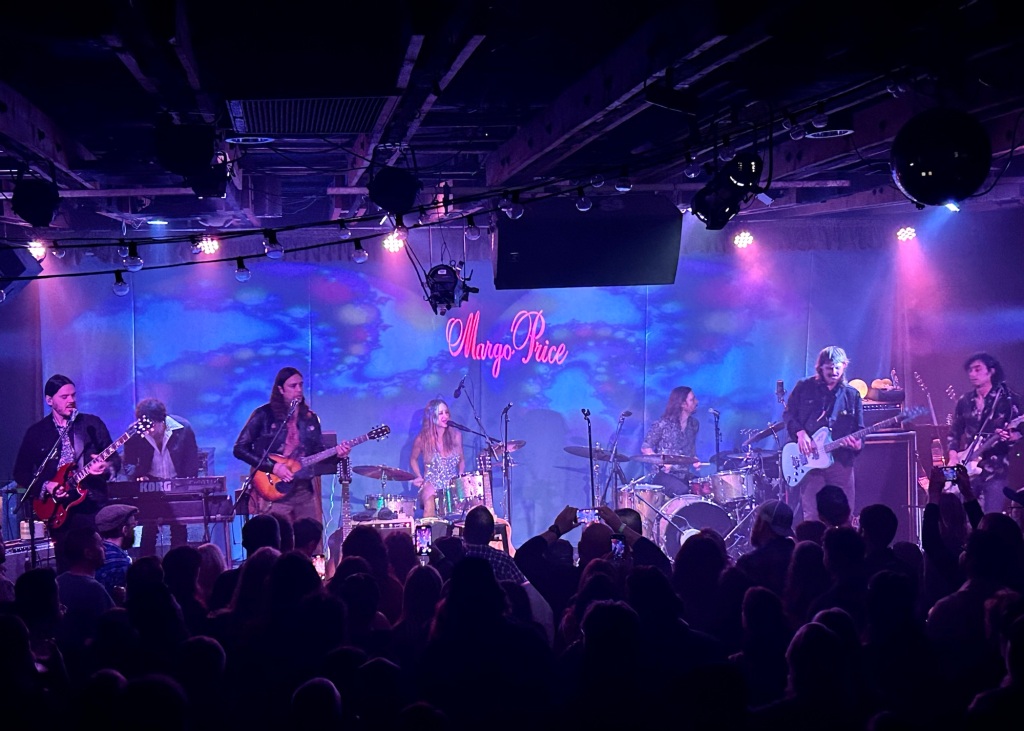
Strays II is bundled with Strays I on streaming services:

Heartbreaker
(2000)
Ryan Adams has been trying to live up to this, his debut masterpiece, for the last quarter of a century. While his band Whiskeytown was still burning to the ground, Adams ducked into a Nashville studio for two weeks of sessions with Gillian Welch and David Rawlings, supervised by Ethan Johns. The album is said to be inspired by Adams’ break-up with music industry publicist Amy Lombardi. This is Adams’ best LP, and it perfectly captures the Americana zeitgeist of the turn of the 21st century.
Pitchfork at the time gave it a glowing 9.0 review, stating that: “Heartbreaker is a drinker’s album, an ode to sadness that deals exclusively with all the dark and dirty corners of the human heart. It’s music written in the language of loneliness, depression, and, above all, heartbreak, in all its varied forms.”
I was reminded of this album while working on a review of a Laura Marling album also produced by Ethan Johns. Johns is the son of legendary producer Glyn Johns. Although Johns is primarily a record producer, mixer, and engineer, he is also a multi-instrumentalist who has toured as a backup musician. When I think of Johns, the first thing that comes to mind is the Ryan Adams classics he produced: Heartbreaker and Gold.
The album opens with an amusing argument between Adams and Rawlings regarding Morrisey and then leaps into the album’s first song, “To Be Young (Is to Be Sad, to Be High).” The song wonderfully captures a mood: savoring your misery – which is Ryan’s brand that has carried him for his career. This is not a unique mood in country music; there is even a term for it: “high lonesome.” It is performed as a raucous rock song with a soaring bridge that milks the high lonesome. The pairing of an argument about one of the mopiest of rock stars, Morrisey, and the album’s first song could not be more perfect.
“My Winding Wheel” slows down from the previous song to a fingerpicked acoustic guitar ballad that is a plea for a soulmate.
“Amy” is another acoustic guitar ballad, but this time augmented by sad-sounding strings. The soulmate has been lost.
“Oh My Sweet Carolina” (Ft. Emmylou Harris) is another love song. Instead of lamenting a lost lover, this lamenting a place: the Carolinas, where Adams grew up. Emmylou has made a career of these kinds of guest appearances – she is the most outstanding guest vocalist in country music.
“Bartering Lines” is a weary song about being a loser in a shithole town.
The heartbreak continues with “Call Me on Your Way Back Home.” The narrator’s lover has left, and all he can hope for is that she remembers him. The song ends with a beautiful, mournful harmonica solo.
“Damn, Sam (I Love a Woman That Rains)” – Adams opens the song with an admission that he is a world-class sad sack: “As a man, I ain’t never been much for sunny days” in this song praising a crying girlfriend.
“Come Pick Me Up” opens up with another Dylanesque harmonica solo and then explains his heartbreak with this brilliant chorus:
“Come pick me up, take me out
Fuck me up, steal my records
Screw all my friends, they’re all full of shit
With a smile on your face, and then do it again
I wish you would”
“To Be the One” is more sadness. For me, this is the weakest track on the album. The narrator is feeling so sorry for himself that I find it pathetic.
“Why Do They Leave?” describes the timing problem of love; just as the narrator falls in love, the lover leaves. Was he too late in showing his affection? Would it have never worked out anyway?
“Shakedown on 9th Street” finally brings up the pace with a full-on rocker. Sadness has escalated to anger: “I was just gonna hit him, but I’m gonna kill him now.”
After the anger, “Don’t Ask for the Water” moves to the bitterness of the loss: “Don’t ask her for the water, ’cause she’ll swallow you down (or “teach you to cry” or “you’ll sink like a ship”).
“In My Time of Need” introduces a new decent: the narrator is ready to give up.
On “Sweet Lil’ Gal (23rd / 1st),” Ryan switches to piano and ends the album on a particularly bleak point. I can’t figure out if he is remembering a lover or something else like a drug. Is 23rd and 1st referring to a NYC street address? It is spooky that Ryan foreshadows 9/11 one year early with this lyric: “Steals my shirt, makes me hurt / In the field where my plane went down.”
I don’t see myself as a sad or depressed person, but boy, do I like sad music and high lonesome in particular. Ryan Adams delivers a high-lonesome masterpiece. Adams has flirted with this formula for the last 25 years but has never struck the landing as effectively as Heartbreaker.
Personel:
Ryan Adams – vocals, acoustic guitar, electric guitar, harmonica, piano, banjo
Ethan Johns – drums, bass, Chamberlain, glockenspiel, B-3, vibes
David Rawlings – backing vocals, acoustic guitar, electric guitar, banjo, tambourine
Gillian Welch – backing vocals, banjo, acoustic guitar, electric bass, “voice of Lucy”
Pat Sansone – piano (“Oh My Sweet Carolina,” “Come Pick Me Up,” and “Why Do They Leave?”), Chamberlin and organ (“Bartering Lines”), backing vocals (“To Be Young (Is to Be Sad, to Be High)” )
Emmylou Harris – backing vocals (“Oh My Sweet Carolina”)
Kim Richey – backing vocals (“Come Pick Me Up”)
Allison Pierce – backing vocals (“Why Do They Leave?”)
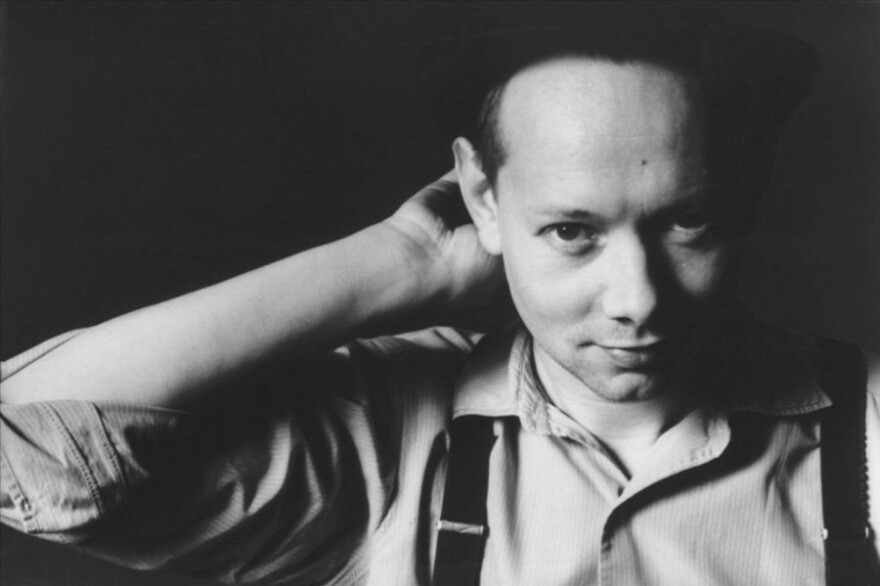
An esteemed former colleague, who has become a friend in retirement (I will refer to him as Jim), reminded me that Joe Jackson is one of my essential musicians. Jim and I have been having email conversations over the last few months about music and specifically sharing our favorite bands and artists. He recently emailed me:
So, why is Joe Jackson so good, yet he was not on our favorite artists lists? I am just listening to his greatest hits (again), and I am always just enamored, but I never follow up and try to listen to, say, his first breakthrough album all the way through. Why? Ideas?
The email reminded me I was a massive fan of his debut, Look Sharp (1979), through Body And Soul (1984). Jackson has been out of my listening rotation for so long that I have forgotten about him in the many music discussions with my friend Jim – thanks for the reminder!
Beat Crazy (1980)
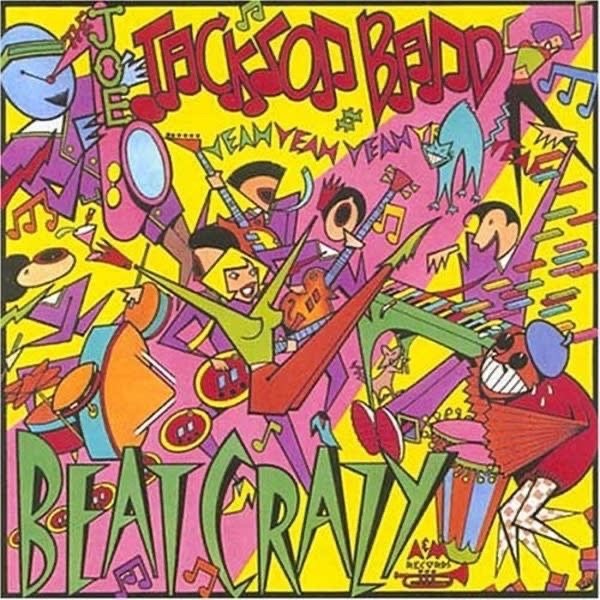
My introduction to Joe Jackson was his third album, Beat Crazy (1980). I knew his debut, Look Sharp! (1979) because it had hits, but I didn’t own it. I missed his second album, I’m the Man (1979). I bought Beat Crazy shortly after it was released because of Jackson’s reputation and, more importantly, the cover art. I had not heard any of the songs before buying it (it was a commercial flop with next to no airplay). Beat Crazy opened my ears and mind to Jackson’s immense talent, making me a Joe Jackson fan.
Beat Crazy was love at first needle drop! It was the epitome of the best of New Wave music: smart but punky and with pop hooks galore. I loved the cover art, the songs, the performance, and the attitude. It was hip but not popular. It was in constant rotation on my turntable the winter of 1980/81 (side one mostly), and it provided an essential soundtrack to an important year of my life: October 1980 – September 1981. A year earlier, I had dropped out of college, moved in with an old friend, got a bank teller job, and partied like a rock star for a year. By the fall of 1980, I was officially bored with the party, and it was time to get my shit together. A girl at work had caught my eye, and by January of 1981, we were dating – that girl eventually became my wife of the last 40 years. So Beat Crazy is an essential album, but I bet I haven’t listened to it in a decade. Jim’s email motivated me to revisit the Joe Jackson catalog, and Beat Crazy was the first album I returned to.
Listening to it now, it still sounds as great as I remember: fresh, adventurous, yet accessible. It foreshadows the fantastic music that would come from Jackson over the next few years.
Look Sharp! (1979)

After falling for Beat Crazy, I returned to Jackson’s debut, Look Sharp! It is an impressive debut with several hit songs, including: “Is She Really Going Out With Him?” which came out a few months before the album. Jackson and his band were influenced by reggae, and you can feel that influence in the songs and production. The album was both a critical and commercial success, putting Jackson in the same esteemed category as his contemporary Elvis Costello – although Jackson was, over time, unable to keep up with EC. Although there are songs I love on Look Sharp!, it doesn’t resonate with me, like Beat Crazy and some other albums in Jackson’s catalog. As mentioned earlier, Jackson’s second album, I’m the Man (also from 1979), never entered my consciousness (I do have a copy in my collection, but I couldn’t name you a song off the album), therefore it will not be included in this retrospective.
Joe Jackson’s Jumpin’ Jive (1981)
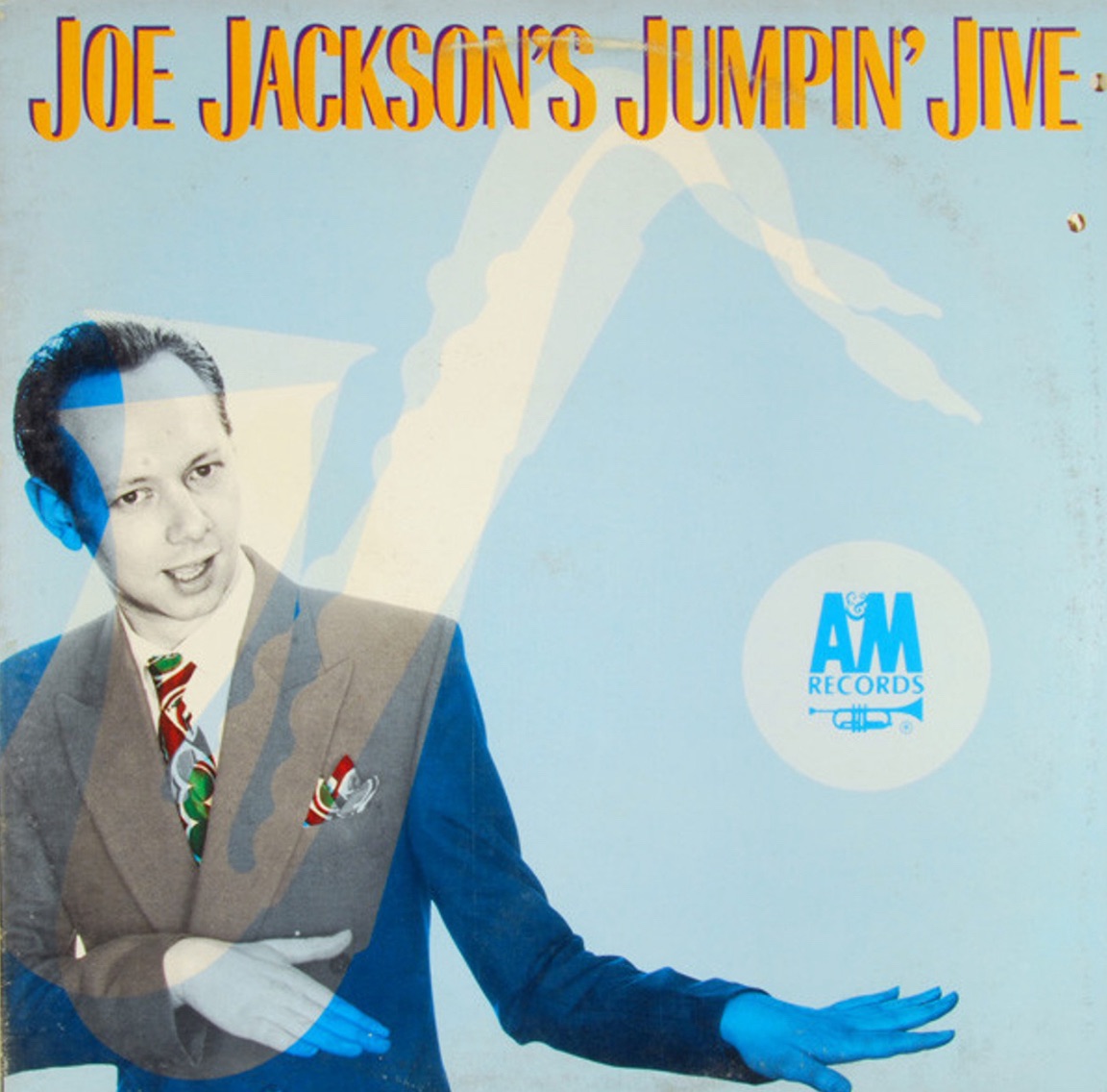
By the time Jumpin’ Jive came out, I was a fan willing to take whatever ride Joe would take me on. Jackson took a left turn with this album: it was a covers album of songs associated with 1940 swing and jump blues songs, specifically songs made famous by Louis Jordan and Cab Calloway. Despite my already-established interest in swing and jazz music, this music was unfamiliar to me. I had not even heard of Louis Jordan at the time. Despite this being a weird departure from Jackson’s New Wave trajectory, it worked and was even a minor hit. I loved the album as it struck a chord with my appreciation of Jackson and my love of jazz music in all its forms. Yet this is not an album I return to. If I was in the mood for jump blues, a rare mood, I would listen to the originals, Louis Jordan or Cab Calloway, versus this love letter to the style.
Night and Day (1982)
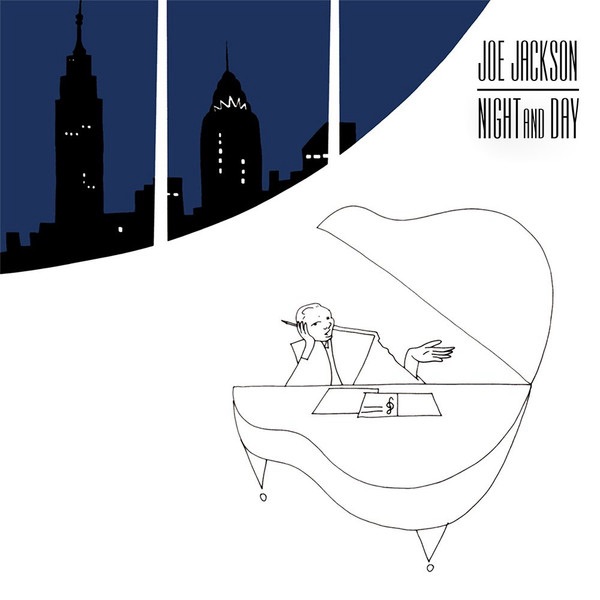
Jackson’s fifth album was a grand slam, as it was both a critical and commercial success. It is my favorite Joe Jackson album, and although it has not been in my recent listening rotation, it comes off the shelf every few years. It is a jazz-pop masterpiece.
The only time I have seen Joe Jackson live was on the tour supporting this album (9/23/82 at the Minneapolis Orpheum Theater). It is one of my top 25 live shows.
The album is Jackson’s successful attempt at a contemporary update of Cole Porter and his expression of his love affair with New York City at the time (he eventually fell out of love with NYC – he is quoted as saying, “It’s as if the city and I had a hot love affair and now we’re just friends”). The album has a jazz feel – it is a New Wave Steely Dan. Jumpin’ Jive seemed like a novelty record at the time, but I am convinced that without going through that step, he never would have accomplished a masterpiece like Night and Day.
Mikes Murder Soundtrack (1983)

I bought this album at the height of my obsession with Joe Jackson. It was recorded about the same time as Night and Day, and the songs sound like Night and Day outtakes (in fact, Mike’s Murder tracks were included in the Night and Day deluxe reissue). The film stiffed, as did this soundtrack. It’s pleasant enough but not essential.
Body and Soul (1984)
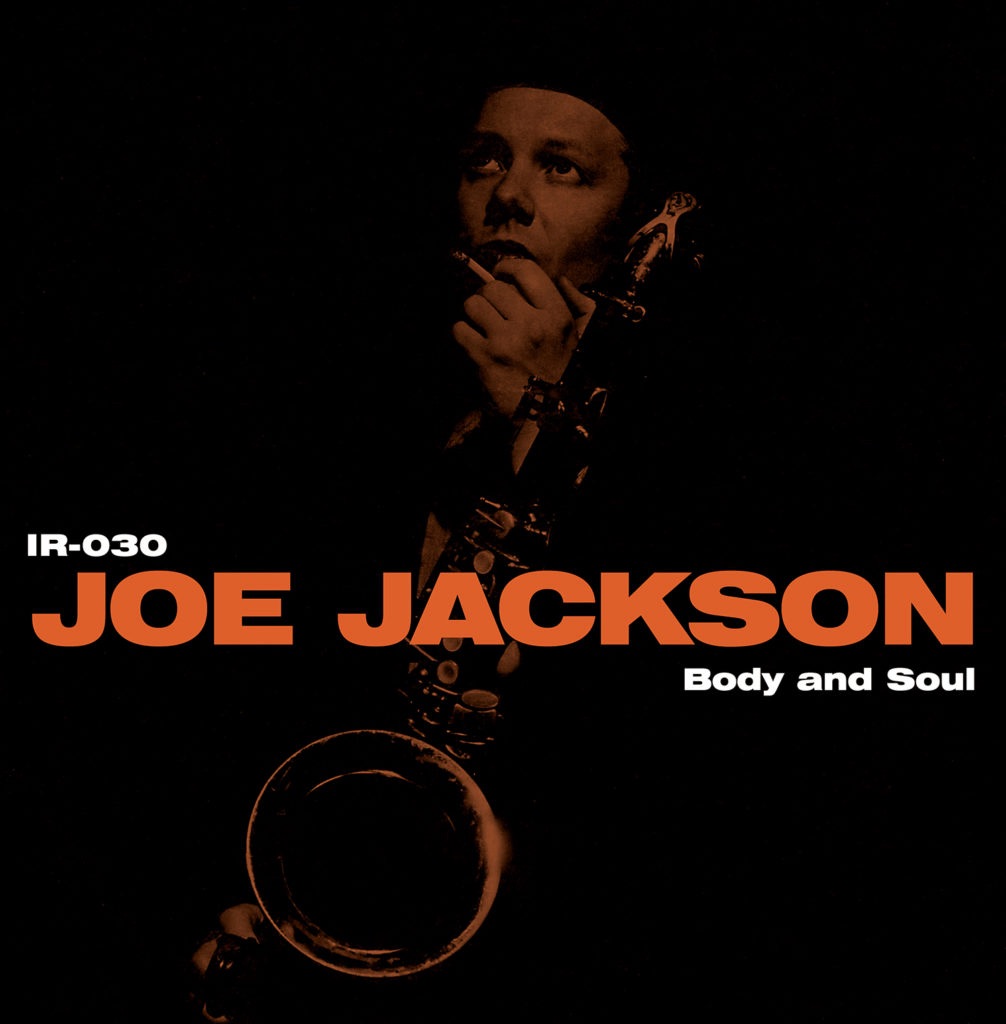
Although I would continue to buy Joe Jackson albums, this is the last Jackson album that resonated with me. This time, Joe goes with a Latin jazz sound and pulls it off masterfully. The album has one of Jackson’s best pop songs: “You Can’t Get What You Want (Till You Know What You Want).” The big band sound of this album is the perfect follow-up to Night and Day
I love the cover art based on Sonny Rollins Vol. 2 (Blue Note 1957). Sonically, this is a great-sounding recording and would be great for testing driving HiFi equipment (AKA a reference recording). It was Jackson’s first fully digital recording (an innovation at the time, but what would ultimately become an industry standard).
Summary
Joe Jackson had a brilliant pop career in the late 70s and early 80s. Then, his artistic ambition outpaced his audience as he veered off into jazz and classical music; that is, he got weird and lost me. I recently hopscotched through a few of his more pop-oriented albums from the ’00s, and he still has it, even if no one is listening.
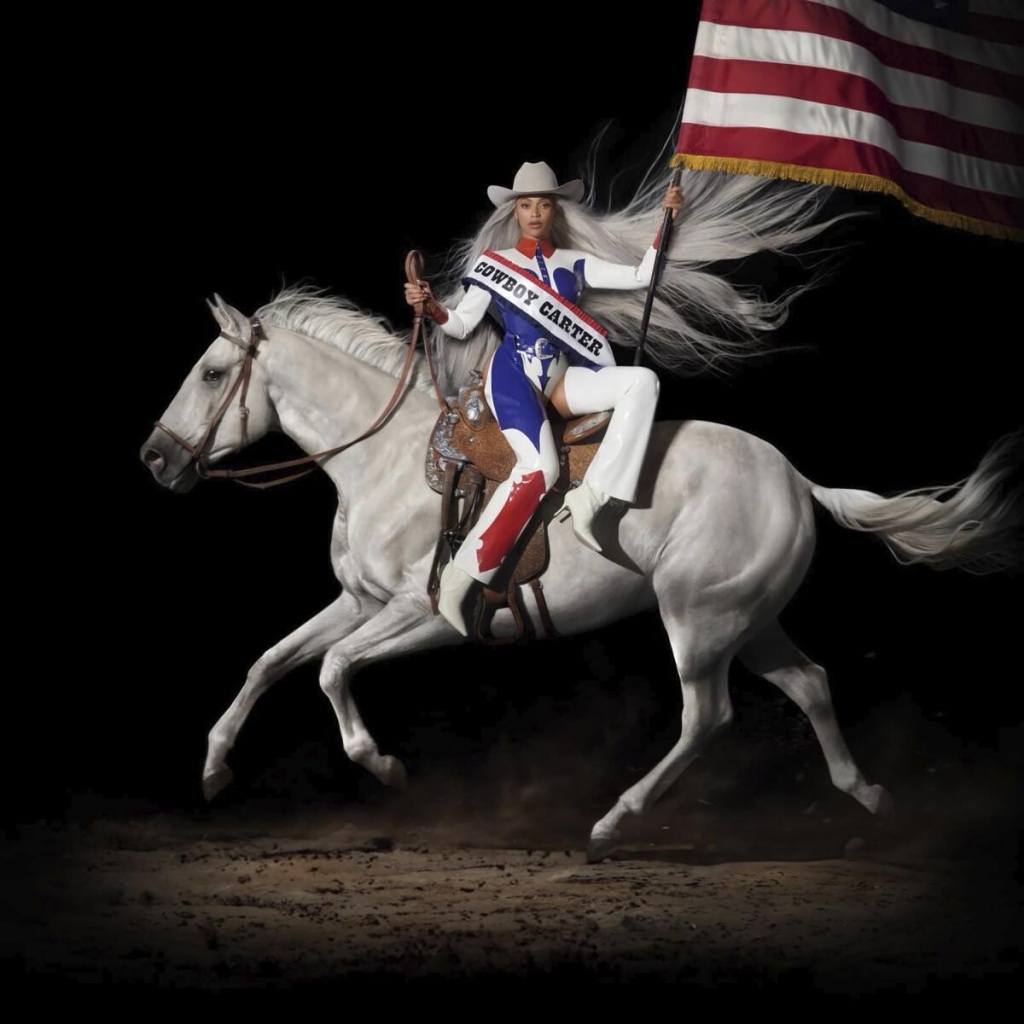
I am a 65-year-old white cisgender male—not precisely in the Beyoncé demographic. But I am also a musichead who likes a broad range of genres (with Americana and singer-songwriters dominating). Of course, I know Beyoncé, and I have listened to many of her songs and liked some of them. I have heard several of her albums (album guy vs. a singles guy), but none has resonated with me; therefore, I have not been a Beyoncé fan (spoiler alert: I am now). I appreciate her as an artist, but she hasn’t clicked with me. The pre-release hype for this album was that it would be her Country album. I listened to the two singles “TEXAS HOLD ‘EM” and “16 CARRIAGES,” and they are Country (ish), and I liked them – enough so that I was motivated to listen to COWBOY CARTER the moment it was released (9:00 MST on March 28, 2024 – one of the benefits of living in Phoenix is I get to hear new releases “early”). On first listen, a Beyoncé album resonated with me for the first time. COWBOY CARTER has been in constant rotation since, and with each listen, I like it even more and have become obsessed with trying to figure it out. In his review, New York Times music critic Jon Pareles points out that Beyoncé albums are “meant to be discussed and footnoted, not just listened to.” That is precisely what I find myself doing.
As much as I love the album, I also recognize it as a hodgepodge. It feels like Bey is showing off: “Look at all the genres I can do and how profound I can be!” Then it hits me, Bey is pissed at the music industry. Despite all her success, she is underrated. Consider Jay-Z’s recent speech at the Grammys, where he calls them out for slighting his wife: “I don’t want to embarrass this young lady, but she has more Grammys than anyone and has never won album of the year. So even by your own metrics, that doesn’t work.” So Bey has made an album for guys like me and the old white guys who vote for the Grammys (and anyone else who has not accepted her genius): “Here you go, assholes, try to dismiss this.” COWBOY CARTER is like how Taylor Swift’s folklore opened my ears to her music by working in a style in my comfort zone (in TSwift’s case, Americana). Beyoncé is playing in a place closer to my neighborhood (Country, rock, folk, Americana, old school R&B, etc.), something an old white musichead can understand. I can’t dismiss COWBOY CARTER; it is brilliant; it is the gateway drug for people like me. This is just what I needed to become a Beyoncé fan.
So, on to the music, let’s start with the teaser singles and then move on to the rest of the album.
“TEXAS HOLD ‘EM” is what I would expect in a Beyoncé Country song: sassy, danceable, twangy guitar and banjo (courtesy of Rhiannon Giddens), and most importantly, a banger. It is Queen Bey’s version of a hoedown: “Furs, spurs, boots.” This is a great first single and could be the song we remember from this album a decade from now (but there are several other candidates, too). “16 CARRIAGES” is a different beast; it is a serious song where Bey contemplates the sacrifices of being a mega pop star for a quarter of a century. I assume the 16 carriages refers to the semis associated with an arena concert. I wonder if she chose 16 to reference the Junior Parker/Elvis song “Mystery Train” (“Train I ride, sixteen coaches long”). Sonically, it is adventurous and a more challenging listen than the pure fun of “TEXAS HOLD ‘EM.” It suggests the new album is not a novelty but a big statement. It sounds better in the context of the album. The two singles accurately foreshadow COWBOY CARTER: it is fun but also a huge artistic statement. Bey has met me at a place where I can more than intellectually appreciate her; I can now enter the BeyHive as a fan.
After signaling that COWBOY CARTER would be a Country album (including the two teaser singles), she does a bait-and-switch and says, “This isn’t a country album. This is a ‘Beyoncé’ album.” It has Country elements, but it is more in the tradition of a singer-songwriter album (ironic given that Bey creates more like a movie director, that is, collaboratively, vs. the typical solitary methods of singer-songwriters). It is also genre-diverse, and Beyoncé puts on a clinic of her magnificent voice performed in several styles (Country, pop, hip-hop, rock, folk-rock, and even opera) – it is like there are ten different vocalists on the album.
“AMERICAN REQUIEM” opens as a solemn hymn with a riff that reminds me of Buffalo Springfield’s “For What It’s Worth.” Lyrically, Bey is claiming her right to the Country genre by alluding to her controversial performance of “Daddy Lessons” with the Dixie Chicks at the 2016 Country Music Awards. She was criticized by Country fans who found issues with her liberal politics and lack of Country cred.
“It’s a lot of talkin’ goin’ on
While I sing my song
Can you hear me?
I said, ‘Do you hear me?'”
“BACKBIIRD” A great example of Beyoncé’s genius on COUNTRY CARTER is covering the Beatles’ (more specifically, McCartney’s) “Blackbird.” In the past, McCartney has said that the lyrics were inspired by hearing the call of a blackbird in India and racial tension in the Southern United States. The lyric: “you were only waiting for this moment to arise” is about black people’s struggle in the US. In 2018, McCartney elaborated on the song’s meaning, explaining that “Blackbird” should be interpreted as “black girl” (“bird” is a British term, similar to the American term “chick” for girls/women) in the context of the civil rights troubles in southern 1960s US, specifically the Little Rock Nine. Beyoncé uses the song to point out the struggle of black women (blackbirds) in Country music – a genre black people helped invent. To emphasize her point, she is joined on the track by four contemporary “blackbirds” of Nashville: Tanner Adell, Brittney Spencer, Reyna Roberts, and Tiera Kennedy. It is a relatively straight cover of the Beatles classic, but the fact that Bey and black Nashville artists are performing it is Bey’s demand for women of color to get their “moment to arise” in Country music.
“PROTECTOR” opens up with Carter’s daughter, Rumi, asking her mom to play the lullaby, and Mom obliges. The song is a gorgeous Country ballad. The arrangement is acoustic guitar-focused with a dash of Gary Clark Jr.’s slide guitar. Lyrically, it is a mom’s pledge to protect their child.
“MY ROSE” is a Beyoncé choir (Bey overdubbing herself – an old Joni trick). It is a short song about accepting your and others’ beauty.
“SMOKE HOUR ★ WILLIE NELSON” is a hip-hop skit featuring Willie introducing “TEXAS HOLD ‘EM.” But first, there is the spinning of an imaginary radio dial where we hear snippets of Son House’s “Grinnin’ in Your Face,” Sister Rosetta Tharpe’s “Down by the Riverside,” Chuck Berry’s “Maybelline”, and Roy Hamilton’s “Don’t Let Go.” Then Willie instructs us to spark one up and enjoy “TEXAS HOLD ‘EM.”
“BODYGUARD” is one of my favorite tracks on the album. It has a sexy lilt and is neither Country nor R&B, but closer to Stealy Dan with better vocals, that is pop jazz. This is the Raphael Saadiq show – he rocks the house with his funky bass, guitar, and production. I love Lemar Carter’s Motownish drums – man, can he create a groove.
“DOLLY P/JOLENE” – Dolly throws Bey a soft pitch that Bey hits out of the park. This is not a reverent cover; Bey changes the album’s mood from Dolly’s resignation to defiance. There are even some lyric changes like: “Jolene, I know I’m a queen, Jolene/I’m still a Creole banshe bitch from Louisiane (Don’t try me).” Yup, don’t mess with QueenBey!
“DAUGHTER” is not about the narrator’s daughter but the narrator as the daughter of her father. Bey’s vocals and arrangement reminded me of Joan Baez. At the bridge, she becomes an opera singer and performs the famous opera aria “Caro Mio Ben,” a song about loneliness due to the absence of a loved one. The aria’s message is in stark contrast to the narrator’s violent mood toward their lover’s infidelity.
“SPAGHETTII” Bey presents a witness, Linda Martell, the first Black female artist to join the Grand Ole Opry, who says in the spoken word section of “SPAGHETTII”: “Genres are a funny little concept, aren’t they? In theory, they have a simple definition that’s easy to understand, but in practice, well, some may feel confined.” Bey doesn’t feel confined and proceeds to rap, contrasting with the rest of the album’s predominantly Country, pop, and R&B styles. I assume “spaghetti” refers to “Spaghetti Westerns,” genre busters like Bey.
“ALIIGATOR TEAR” sonically has a singer-songwriter vibe, a cross between Laura Marling and Sheryl Crow. The song suggests that some of her accolades, for example, her many Grammys, are unctuousness (alligator tears). I love The-Dream’s (Terius Adamu Ya Gesteelde-Diamant) production.
“SMOKE HOUR II” is another Willie Nelson spoken word interlude. This time Willie is giving his full endorsement of Beyoncé genre jumping “…if there’s one thing you can take away from my set today, let it be this: sometimes you don’t know what you like until someone you trust turns you on to some real good shit. And that, ladies and gentlemen, is why I’m here.”
“JUST FOR FUN” (with Willie Jones) is a lovely modern country rock tune with a heavy dose of gospel produced by Dave Hamelin (The Stills). I have never heard of Willie Jones – he kills it with his sweet country voice. It turns out that Willie is an X Factor kid. Pretty low on the totem pole – this is one hell of a bump. It is refreshing that Bey ultimately does this music thing for fun:
“I’m goin’ all out just for fun, I am the man, I know it
And everywhere I go, they know my name
So I laugh and I lie and the coyotes cry
And, uh, time moves quickly and so do I, so do I
So I’ll say my goodbye”
“II MOST WANTED” (with Miley Cyrus) is a jam! These two are perfect duet partners. They are both distinctively different singers, but they are both divas. The song sounds like an interpolation of Fleetwood Mac’s “Landslide.” Googling this song, it appears it is a tribute to Beyoncé’s mother-in-law, Gloria Carter, and her wife, Roxanne Wiltshire. Love these lyrics:
“I’ll be your shotgun rider
‘Til the day I, ’til the day I die”
This should be a massive hit on Country Radio, or the world is wrong. I would love for Lady Gaga and someone like Annie Lenox to cover this.
“LEVII’S JEANS” (with Post Malone) is a trashy Country song with modern R&B production values. I love it!
“Boy, I’ll let you be my Levi’s jeans
So you can hug that ass all day long”
Tacky but damn clever. Post Malone is a perfect cameo with his rap-singing. Tip of the hat to Nile Rogers for the funky folk guitar riff.
“FLAMENCO” is a short song that has a Joni Mitchell vibe: vocally, the arrangement, and lyrically (“Realize that you don’t know what you got until it’s gone”).
“THE LINDA MARTELL SHOW” is a spoken word interlude where Martell introduces the wildest song on the album. “YA YA” has a lot going on – this is the most over-the-top track on the album – lyrically and in the arrangement. It is a brilliant pop cocktail of 60s pop (“These Boots Are Made for Walkin’” and “Good Vibrations”), Tina Turner, James Brown, Little Richard, and Elvis. Bey is resurrecting the Chitlin Circuit and reminding us of the genius of that juxtapositioned with the whitest of pop music from the 60s, which coexisted with Motown and Stax. It is, without exaggeration, a tour de force. I hope it is a huge hit.
“OH LOUISIANA” is a cover/sample of a Chuck Berry song. It is a brief tribute to Bey’s Louisiana Creole heritage. It is also the second time she invokes Berry, who supercharged Country music to help create Rock ‘n Roll.
“DESERT EAGLE” is a short funk jam with a prominent bass riff. The song is sexual (desert eagle is a sex position).
“RIIVERDANCE” is an Irish dance tune performed over a rhythm of Dolly-inspired nail percussion. The dance feels like an analogy of the excitement of love.
“II HANDS II HEAVEN” is the kind of pop and hip hop I equate with Beyoncé. Lyrically, I am not sure what is going on here, but Bey’s vocals are outstanding.
“TYRANT” (with Dolly Parton)—beyond the intro, this is barely Dolly. Again, she is working in the pop/hip-hop genre. She uses the term “tyrant” to describe her power, especially her sexual power.
“SWEET ★ HONEY ★ BUCKIIN’ (with Shaboozey)” is three songs. The “SWEET” section opens with a hip-hop Patsy Cline interpolation, then goes into a Shaboozey rap. This first section focuses on how far black folks have come: “We’ve come a long way from the rough ride from the railroads to the rodeos, sweet country home.” In the “HONEY” section, Bey is joined by Pharrell Williams. It has a 60’s girl group feel and is about making love. The “BUCKIIN” section also includes Pharrell and has a hip-hop feel. This section means she is “bucking” trends and will do what Bey will do.
“AMEN” ends the album with a song that echoes the opening track. It is a hymn that brilliantly concludes the album:
“This house was built with blood and bone
And it crumbled, yes, it crumbled
The statues they made were beautiful
But they were lies of stone, they werе lies of stone
Trumpets blarе with silent sound
I need to make you proud
Tell me, can you hear me now?”
Beyoncé has delivered an impressive piece of art. It is a history lesson on how the black (and female) experience has been significant in developing Country music and other “white” pop forms. Despite demanding to be taken seriously, the album is fun. I am embarrassed as a musichead that I did not understand what a significant talent Beyoncé is. Her vocals are insane – it is like several vocalists are on the album. The juxtapositions are a bit messy, but I am okay with that, I like the variety. This is the most sophisticated pop I have heard in a long time.

I have been a Norah Jones fan since February 26, 2002. I know that specific date because I had read the pre-release promo back in the day, and based on what I read, I was confident enough to buy her debut album on CD on release day without hearing it first. It was love at first sight (actually, at first listen). I was not alone: Come Away with Me sold over 27 million copies.
Over the next 22 years, Norah did not release a bad album, however, there have been some albums that didn’t grip me. Good news: Visions grips me. Anytime Norah wants to get a little weird, I am all in – Visions is a little weird (adventurous) in the retro funky soul grooves it explores.
The collaboration of Norah and Leon Michels is inspired. Michels is the album’s producer, cowriter, and backup musician (he is a multi-instrumentalist). His claim to fame is he played saxophone in Sharon Jones & The Dap-Kings and has performed with Lee Fields & The Expressions, Dan Auerbach’s band The Arcs, Menahan Street Band, and his own project El Michels Affair. Michels and Jones first collaborated on the single “Can You Believe” and later worked together on Jones’ 2021 holiday album I Dream of Christmas (which I have never listened to – I will now based on Visions).
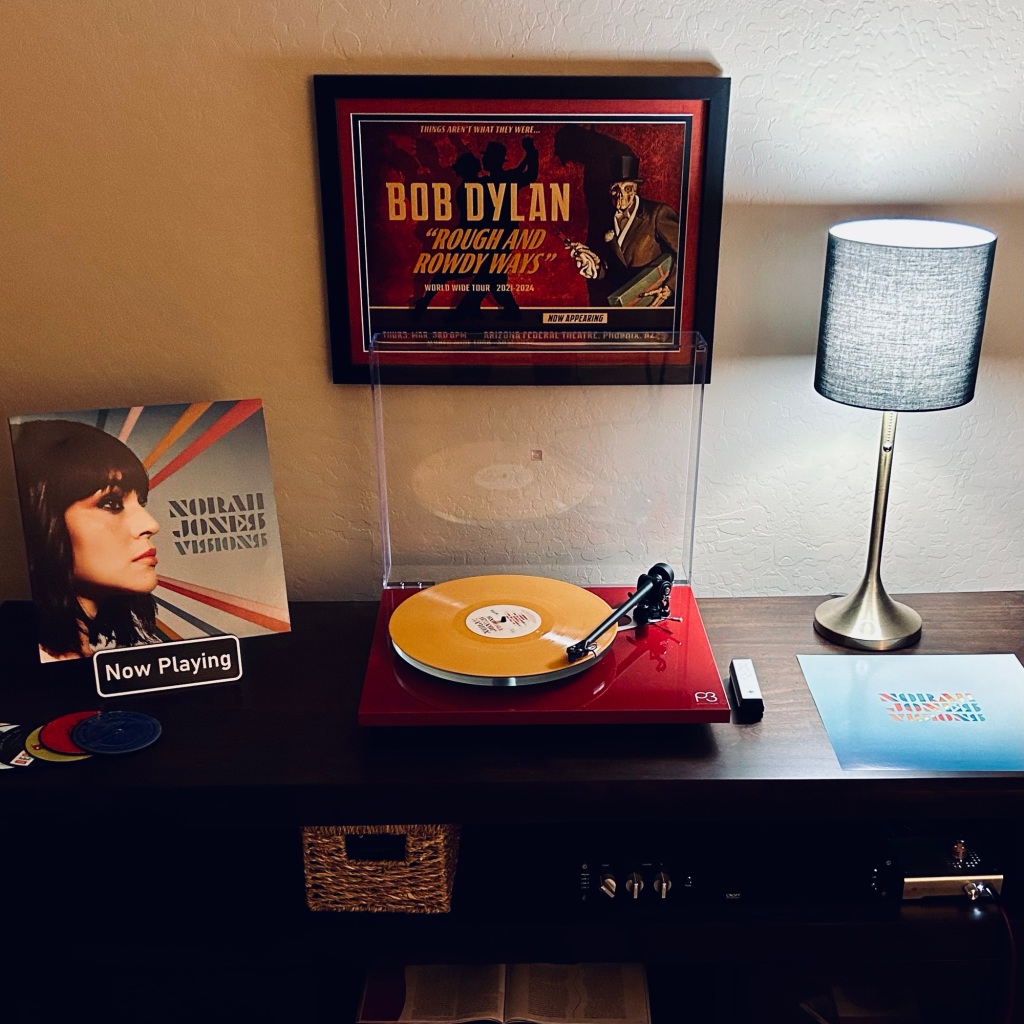
Per the Visions pre-release promo, Norah said: “The reason I called the album Visions is because a lot of the ideas came in the middle of the night or in that moment right before sleep, and ‘Running’ was one of them where you’re half asleep and kind of jolted awake. We did most of the songs in the same way where I was at the piano or on guitar and Leon was playing drums and we were just jamming on stuff. I like the rawness between me and Leon, the way it sounds kind of garage-y but also kind of soulful, because that’s where he’s coming from, but also not overly perfected.”
Here are some track-by-track comments:
“All This Time” (Jones/Michels) opens the album and wow what a sexy song! I could imagine a 70s soul/R&B male vocal group doing this, for example, the O’Jays or The Stylistics. Love these lyrics:
“All this time, I think of you
I think of you
Stay with me, I’ll make it easy”
“Staring at the Wall” (Jones/Michels) sounds like an indie version of Bonnie Raitt and I can imagine Bonnie covering it in a blues-rock style. Norah’s guitar playing has advanced to the point that it rivals her piano playing. It is nice to have this guitar edge as part of her palate.
“Paradise” (Jones/Michels) was the teaser single released a couple of months before the album. It is girl-group splendor – like The Supremes. Norah has developed amazing self-backup vocals (what Joni used to do). Lyrically it is a complex romance – exes back together, it’s hot, but it can’t continue:
“I watch you fall
I try to stop
Waiting for the pain to drop
I know I’ve got to let you go again
Although I never wanted this to end
I know it’s time to let you go”
“Queen Of The Sea” (Jones) – Norah has really developed as a songwriter and singer and this song showcases that. This is a guitar-based arrangement with more amazing self-backup vocals and wonderful horns. The song has a country music vibe. Again her fretwork is so cool – it is minimalistic but groovy AF. This could be a Lucinda Williams’ song.
“Oh, you made a mess out of me
But I’m finally free, ooh
Oh, you made a mess out of me
But I’m finally free
Ooh, oh, ooh”The “Ooh, oh, ooh” almost sounds like “boo-hoo” which is lyrically appropriate.
“Visions” (Jones) is a mournful deconstructed Mariachi/country song with a gorgeous rich vocal.
“Running” (Jones/Michels) sounds like Roxy Music, but with female vocals and point of view. I like the bass (wow Norah you have come a long way from just tinkling keys on a piano) and baritone sax courtesy of Michels.
“I Just Wanna Dance” (Jones/Michels/Steinweiss) sounds late at night. The song has a nice retro soul feel with outstanding horns (assume that is the Steinweiss influence). Norah’s keyboards have a Billy Preston vibe.
“I’m Awake” (Jones) has an empowering lyric. It has a funky keyboard, like something Stevie might do. A little bit of an Al Green (arrangement) and Diana Ross (vocals) vibe too.
“Swept Up in the Night” (Jones/Michels) has some Joni in the arrangements. Again some nice horns.
“On My Way” (Jones/Remm) Pete Remm is Norah’s husband and father of their children, so not surprisingly this is a lullaby.
“Alone with My Thoughts” (Jones/Michels) starts as a mournful piano ballad. The arrangement gets fuller as the song progresses – again great use of horns.
“That’s Life”(Jones/Michels) is jazzy, but schmaltzy, in a good way. It is a nice long goodbye to end the album.
Overall Norah has advanced on several fronts. I assume the pandemic gave her a chance to really woodshed. Her vocals are the most adventurous and satisfying in her catalog. As mentioned earlier her guitar playing now rivals her piano. Her songwriting is strong. The arrangements are loose but serve the songs (however I am not feeling the birds in some of the arrangements). Michels is a strong musician-producer presence – which I like because Norah is a musician’s musician and consummate collaborator. This is my favorite Norah Jones record since Little Broken Hearts (2012) – also an album with a strong producer presence (Danger Mouse). This will clearly be my “best of 2024” list.
I am a little disappointed in the quality of the vinyl, it does not live up to the usual Blue Note standards in that is a little noisy. I did go with the indie record store Orange Blend version – I may need to skip these pretty vinyl records in favor of the old reliable: black. The 24-bit/96 kHz FLAC on streaming sounds fantastic.

I am a long-time fan of The Black Crowes and the Robinson brothers’ various side projects. I was disappointed that Chris and Rich could not find a way to get along to keep their rock ‘n roll train rolling. Right before the pandemic, the brothers mended fences to cash in on the 20th anniversary of their brilliant debut Shake Your Money Maker (1989). That tour, like everything, got paused due to Covid. The tour got going once the world opened up and in 2022 they released an EP of covers inspired by the year 1972. Hopefully, new music was on the way. The brothers have continued to get along: there is more touring and now a new album: Happiness Bastards.
The new album sounds great. They have taken a deep inhale of the Stones, Faces, AC/DC, and Aerosmith and exhaled a cloud of their unique brand of country-fried jam band boogie swagger. It is great to have them back. Nothing new here, but that is ok with me – just finely crafted rock ’n roll (although the collaboration with Lainey Wilson is a nice new spice).
They have taken a deep inhale of the Stones, Faces, AC/DC, and Aerosmith and exhaled a cloud of their unique brand of country-fried jam band boogie swagger.
Here are some track-by-track thoughts:
“Bedside Manners” – Blasts off with classic Crowes’ swagger.
“Rats and Clowns” – Has an AC/DC groove that makes you want to wiggle.
“Cross Your Fingers” – opens with a gorgeous acoustic intro. Chris’ vocals are tender. Then it blasts off with a Led Zepplin-like swagger.
“Wanting and Waiting” was the teaser single back in January and it signaled the boys were back. A bit of an AC/DC groove but clearly with a Crowes’ twist. It rocks! The organ is insane.
“Wilted Rose” (featuring Lainey Wilson)- Happiness Bastards is produced by Jay Joyce who also produces Wilson. I listened to a Chris Robinison podcast and the collaboration with Wilson seemed pretty organic and not clickbait. Wilson’s contribution is perfect – a nice spice to the meal, without overshadowing it.
“Bleed It Dry” has an opening riff that would make Keef proud and Chris’ vocal move like Jagger’s.
“Dirty Cold Sun” is some more Stonesy greaze – tightly sloppy.
“Flesh Wound” – has a fun pop-punk vibe that shows early influences were as much indie rock as classic rock.
“Follow the Moon” has a wonderful classic rock intro – look out riff-master Joe Walsh!
“Kindred Friend” closes the album on a gentle note. This is a gorgeous acoustic-based ballad with a Joe Walsh inflection to Chris’ voice
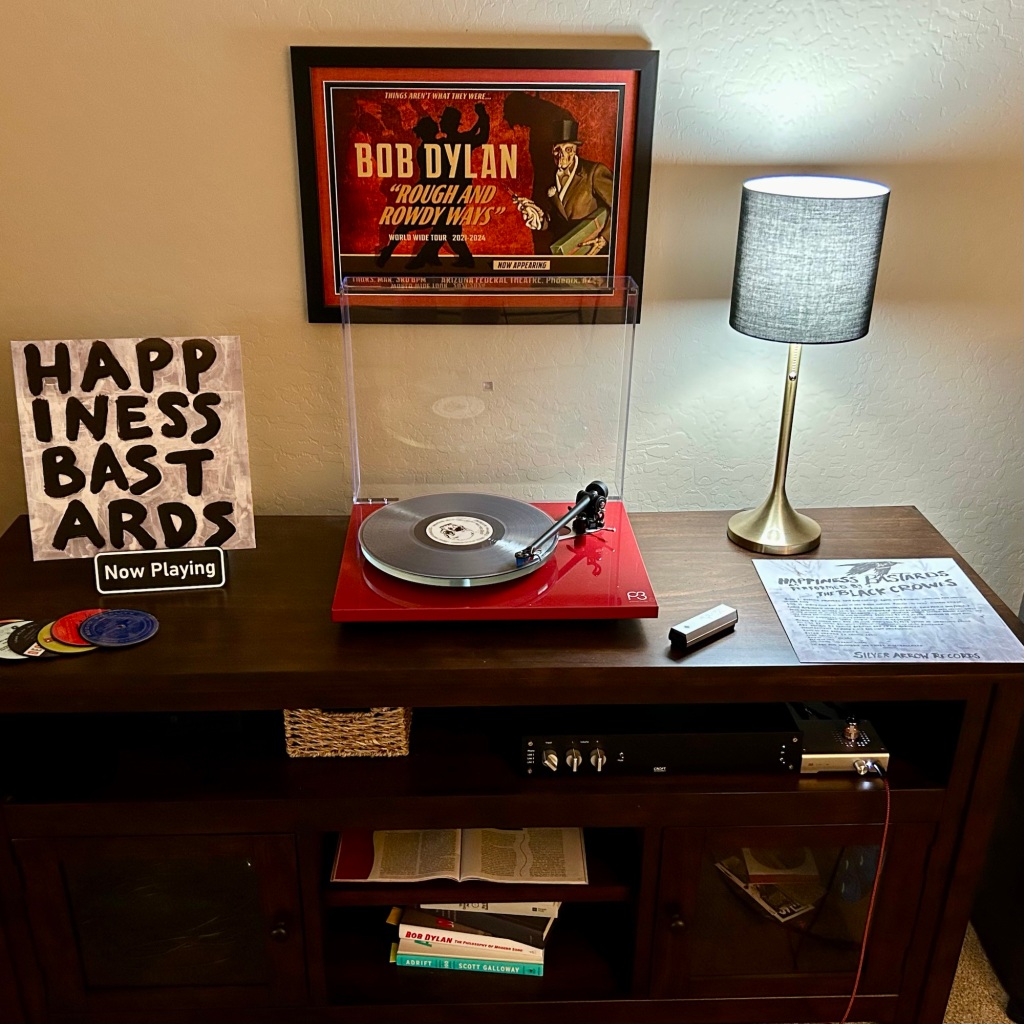
Overall – Happiness Bastards is not a pivot or reinvention – just more of the Crowes’ brilliant craftsmanship. Maybe that is why the cover art is a semi-transparent whitewashing of The Southern Harmony and Musical Companion (my vote for the best in their catalog) album with the album title sloppily scrawled on it (the black cover is a similar concept to Shake Your Money Maker).

I have been looking forward to the new Kacey Musgraves album since the lead single “Deeper Well” was released in early February – it signaled Kacey was back. 2021’s star-crossed never resonated with me, and I was hungry for a return to Golden Hour (2018) form. The One Lo ve movie-inspired Bob Marley cover “Three Little Birds,” released in January, caught my attention too. Unfortunately, Kacey and her team wasted money on a teaser commercial at the Grammys. It got totally lost when Taylor Swift mic dropped that her new album, The Tortured Poet’s Department, is coming on April 19. But now that it is here, I happily declare that Deeper Well is an excellent album.
Like Golden Hour, Deeper Well has a luscious production. However, this is not Golden Hour Vol. 2, as Deeper Well has its own aesthetics. Kacey sings slightly differently: more pop but still with a singer-songwriter vibe (and, when appropriate, a little twang). The lyrics are direct and have a world-weary, smart-ass attitude, but somehow optimistic.
…lyrics are direct with a world-weary smart-ass attitude
“Cardinal” opens the album with a baroque folk-rock intro—like a Byrds’ song. The music has a sad and wistful sound. Lyrically, Musgraves explores the old trope that a cardinal (bird) is a messenger from someone who has died. The narrator tries to decipher the message from the bird. No conclusions are made, just guesses. It is a beautiful start to the album.
“Deeper Well” is a gorgeous single, and if this was the only bright star on this album, this album cycle would be a success. Fortunately, this is just one of several great songs on the album. Again, Kacey is exploring a Bryds-like sound. Lyrically, the narrator is doing some weighty introspection: failed relationships, drugs have become too important, sycophants, etc. All these things need to be left behind and instead focus on a “deeper well.” In an interview, Kacey explains the deeper well metaphor:
“”Deeper Well’ cuts to the core of the human experience for those that are wanting to experience a deep relationship with themselves and also other humans that are existing. The older I get, the more I realize that if you don’t know yourself and you don’t have a deep relationship with yourself, you’re not going to have that with anybody else.”
“Too Good to Be True” – I love good songwriting that puts a twist on a cliche. Kacey delivers a brilliant twist on the “too good to be true” cliche:
“Be good to me and I’ll be good to you
But please don’t be too good to be true”
“Moving Out” is a song that remembers a house that two ex-lovers shared.
“Giver / Taker” is the most conventionally country song on the album, yet it reminds me of a combination of Dylan and Beck.
“Sway” has a country vibe with a Bon Iver(ish) ending. It has a simple message: don’t get uptight, and learn to go with the flow:
“I’ll sway (Yeah, oh yeah)
Like a palm tree in the wind”
“Dinner With Friends” is a ditty that examines romance.
“Heart of the Woods” has an indie rock/Americana feel to the music. Lyrically, this song is more opaque than the rest of the album.
“Jade Green” has Nick Drake vibes, but it also, musically, evokes Chris Isaak’s 1989 hit “Wicked Game.”
“The Architect” is a clever musing on the existence of god via a gorgeous jangling folk arrangement.
“Lonely Millionaire” is a pretty pop ballad with Kacey’s take on “money can’t buy you love.”
“Heaven Is” has a Celtic folk song feel. Lyrically, it points out the simple things that make it great.
“Anime Eyes” is the album’s most elaborate and experimental arrangement. It has a superb crescendo.
“Nothing to Be Scared Of” is a plea to a lover to open their heart and lose their life’s baggage:
“Come to me, and drop your bags
And I’ll help you unpack them
You’re the only one I want to give my love
There’s nothing to be scared of”
This album will burnish Kacey’s reputation as a singer-songwriter and recording artist. The songwriting is simple and direct, and the music/arrangements perfectly augment the lyrics. One odd feature is that many of the songs just end. Kacey could have done a better job sticking the landing on some of these songs. Golden Hour was a huge step forward, moving Kacey from an up-and-coming country star to a brilliant pop singer-songwriter. Deeper Well is evidence that Golden Hour was not a fluke and Kacey is for real.
My introduction to the album was the 24-bit/44.1 kHz FLAC stream on Tidal, and the sonics are like butter.
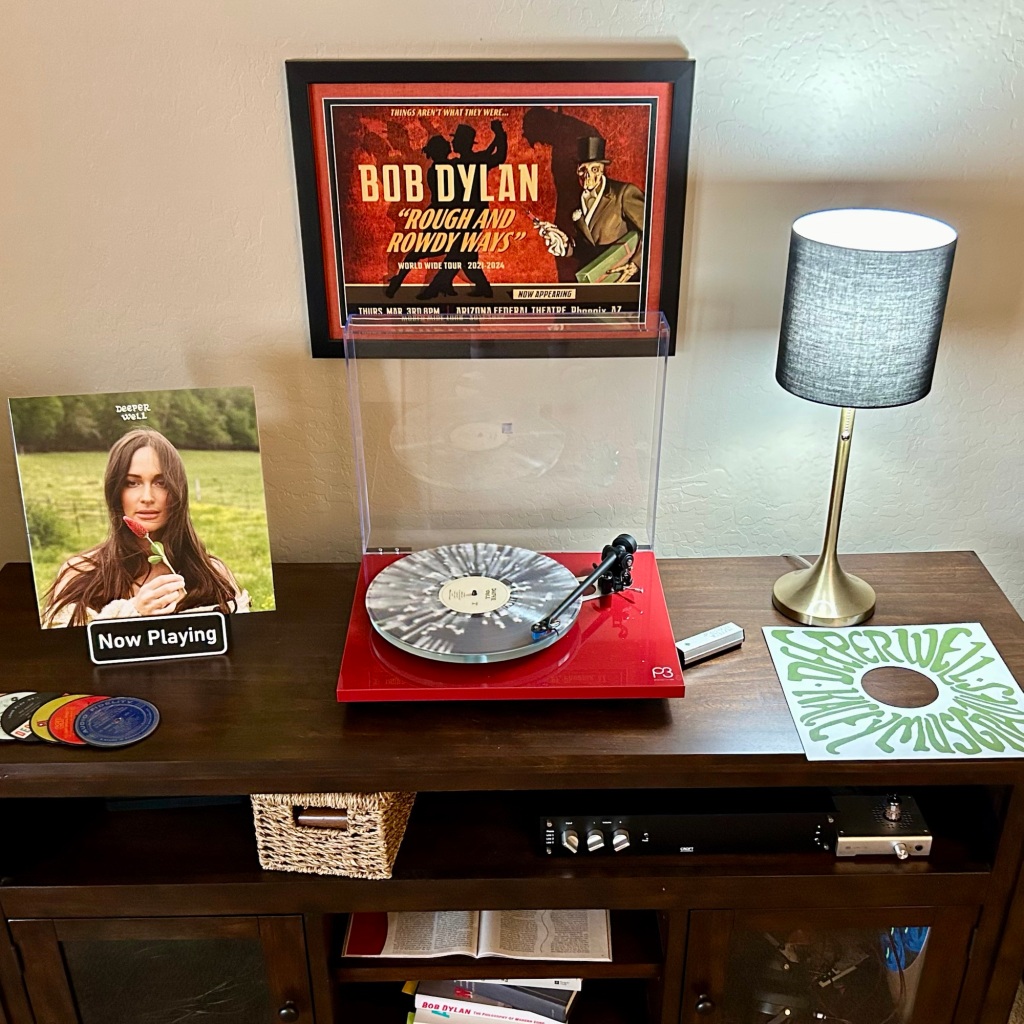
The vinyl version has an excellent master and pressing, and the packaging is well done. I chose the indie record store version and pressed it on “spilled milk” vinyl. The leaves are scented with “KM + Boy Smells” – a nice gimmick.


Dume is yet another “lost” Neil Young album. In the mid-’70s, Neil Young, Crazy Horse, and producer David Briggs lived in the Point Dume area of Malibu. Zuma, named after the beach they lived near, was recorded during that period. When Young was assembling his 2020 Archives Vol II box set he created Dume to combine songs from Zuma with unreleased tracks and mixes from that same period. Of the 16 tracks on Dume, half were not on Zuma. Most of the non-Zuma songs eventually found their way onto other releases (in different arrangements) including three on Rust Never Sleeps. All the Zuma tracks are represented except the CSNY song “Through My Sails.”

Zuma is one of my favorite Neil Young albums so it is a delight to have this new compilation from the Neil Young Archives series. “Cortez The Killer” is my favorite cut on the original Zuma and one of my favorite Neil Young songs. Its groove and the slow grinding lugubrious jam are the sounds that hooked me on Neil Young and Crazy Horse in the first place: heavy metal on Red Wine and Quaaludes. I absolutely love when Neil does this kind of shit. Well, Dume has plenty more. I am going to focus this review on the Dume songs that were not on Zuma. The songs marked with a # were unreleased versions of songs that appeared in other places in the Neil catalog until the Archives Vol II CD/digital box and are new to vinyl. The songs marked * were unreleased songs until the Archives Vol II box and are also new to vinyl. Here is the annotated track list focused on the non-Zuma songs:
“Ride My Llama” # is a Rust Never Sleeps track. The Dume version is full-on Crazy Horse electric grunge compared to the acoustic version on Rust. Both are great and each deserves a place in the catalog.
“Born To Run” * This is not the Bruce song. This is a song I had not heard before. It is a typical vibe of Neil and The Horse.
“Kansas” * Is another song that I have never heard before, but it fits like a glove on this album. It is classic wonderful sloppy proto-grunge from The Horse.
“Powderfinger” # is a highlight of 1979’s Rust Never Sleeps. This version is stunning: it is a pure country rock (or as we call it today Americana) song. I think I prefer it to the Rust Never Sleeps version. Rust and Live Rust were pivotal in my becoming a Neil Young fan and so this is a new essential track for me.
“Hawaii” # is another song that is new to me and represents a unique guitar sound for Neil and The Horse. It foreshadows the New Wave – by five-plus years. It has a really cool groove and sticks the landing with a great ending.
“Too Far Gone” # This song eventually appeared on Freedom (1989). The Dume version is acoustic and is begging for Mick Jagger to cover it in his ironic country voice. The Freedom version is similar, but not identical to the version on Freedom. I prefer the Dume version.
“Pocahontas” # is a folk electric version that is different enough from the Rust Never Sleeps version to be a delightful addition to the catalog.
“No One Seems To Know” # finally made its appearance on the 2018 live album Songs For Judy (as an acoustic piano version). The version on Dume is a similar acoustic piano version.

The vinyl is well mastered and pressed and this album is analog heaven. The wax sounds great on my system – it is tube extasy on the guitar solos. The packaging is nicely done – an enhanced version of the original Zuma LP. The album can be streamed on all services, including Spotify. I use Tidal and Dume is buried in the Archives Vol II compilation (tracks 99-114) in. 24 bit/192 kHz FLAC.
I get overwhelmed by the volume of the Neil Young archival releases, but Dume has muscled its way through the mess and will be a great pre-game to the Neil Young & Crazy Horse show (and new album Fu##In’ Up – which is a redo of 1990’s Ragged Glory when Neil was in his godfather of grunge era) that I will be seeing in Phoenix this spring. I am amazed at how coherent this album is and further amazed that Young was able to use these songs on other albums – especially Rust – they seemed like they belonged on Rust, but Rust and Zume are very much companions and this is even more evident after listening to Dume.